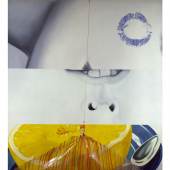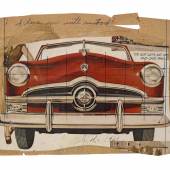James Rosenquist | Visualising The Sixties | London
-
Ausstellung10.09.2019 - 09.11.2019
The 1960s was a defining decade for James Rosenquist (1933–2017), one of the most revered and influential American artists of his generation. His paintings radically tested the possibilities of perception, of the image and of the painted medium itself, propelling him to the centre of art-world attention. At the forefront of his time and the nascent Pop art movement, he combined figurative painting techniques, collage and the use of found objects to convey the contradictions inherent to the American experience – juxtaposing John F. Kennedy and the American Dream with images relating to the Vietnam War, mass consumerism, segregation and technological innovation.
The first UK exhibition in over thirty years with an in-depth focus on this pivotal decade, James Rosenquist: Visualising the Sixties will not only illuminate why the early years of the artist's career were so groundbreaking, but will also demonstrate the innovative and experimental techniques Rosenquist employed throughout the decade, pushing the boundaries of his medium in an era that redefined the field of painting.
The exhibition will feature important paintings on both canvas and plastics from this era that highlight his innovations as one of the earliest pioneers of experiential art, juxtaposed with rarely seen studies for some of his most iconic paintings, which the artist kept private for most of his career. Casting new light on Rosenquist’s practice, influences and motivations – both within and beyond the realms of Pop art – the exhibition includes seminal works loaned from international museums and foundations, alongside those from the artist’s Estate and family. In addition to motorised paintings, works incorporating electric lightbulbs and pieces on diversely shaped canvases, the exhibition will present an interactive hanging piece on strips of Mylar plastic, explicitly designed to be walked through by visitors and never-before exhibited in the UK – described by Rosenquist as ‘painting as immersion’.
Born in Grand Forks, North Dakota in 1933, Rosenquist studied art at the University of Minnesota (1952–54) before enrolling at the Art Students League, New York, also frequenting the Cedar Tavern where he met painters Willem de Kooning, Franz Kline and Milton Resnick. Working as a painter of monumental advertising billboards and painting abstract canvases in his spare time, in 1960 he abandoned commercial painting and set up a studio in Coenties Slip, New York. Cropping, fragmenting and re-colouring images from magazines, uniquely combined with the skills and gestures of sign-painting, Rosenquist began searching for a new language that would differentiate him from the second generation of Abstract Expressionists and set him apart from his peers.
In 1961, vanguard art dealers Leo Castelli, Ivan Karp, Ileana Sonnabend and Richard Bellamy visited Rosenquist’s studio, and his first solo exhibition was held at Bellamy’s Green Gallery, New York, the following year. Pop art was rapidly gaining momentum and the show sold out in its entirety, with many works going to the leading collectors associated with the movement, including Robert Scull, Richard Brown Baker and Count Panza di Biumo.
One of the important early works on display, The Light that Won’t Fail I (1961) – on loan from the Hirshhorn Museum and Sculpture Garden in Washington, D.C. – demonstrates Rosenquist's mastery of collage techniques in painting, layering and transforming his imagery through uncanny, mysterious juxtapositions. The face of a smoking femme fatale, drawn from a Philip Morris advertisement, appears lit by the acid glow of neon lights and overlaid with a pair of sock-clad feet, while an outsized hair comb structures the upper edge of the canvas. The relationships between these disparate elements are elusive – seeming to shift with the viewer's perspective – and enticing in their ambiguity. The painting was purchased from the Green Gallery by the collector Joseph H. Hirshhorn and has since been exhibited in major retrospectives of the artist's work, including The Solomon R. Guggenheim Museum and Whitney Museum of American Art in New York; The National Gallery of Canada, Ottawa; and The Menil Collection, Houston.
By cunningly working up, and at the same time undermining, a photographic surface … Rosenquist is attacking one of our most entrenched visual conventions, and so making a point which can radically affect our relationship to the pictorial world. – Stephan Bann, Art Historian and Emeritus Professor of History of Art at the University of Bristol, 1969
The 60s saw Rosenquist radically experiment with his compositions, embracing vibrant colour palettes, the shaped canvas, and incorporating three-dimensional objects into the picture plane. The innovative use of electrical lightbulbs appeared in works such as Reification (1961), Painting with Bulb (1962) and Small Doorstop (1963–1967). In Reification, a combination of bulbs and empty sockets are set against a fragmented rectangle of pillar-box red, spelling out the first three letters of the painting’s title and suggesting an advertising slogan or shopfront.
-
18.11.2021Sotheby’s To Announce Live Bidding Increments in Ether (ETH) Cryptocurrency For Banksy...
-
15.11.2021 - 19.11.2021Sotheby’s Lifts the Curtain onOne of the Most Important Sales Series Ever Staged $1 BILLION...
-
28.01.2022Sotheby’s New York Master Paintings and Sculpture Part ITotals $91 MillionSecond Highest...
-
Laut dem Kunstmarkthistoriker Gerald Reitinger (1970), gehörte Rembrandt zu den...
-
18.05.2024 - 20.07.2025Created in the artist’s studio north of Salzburg, this new series of paintings and ink...
-
28.11.2024 - 05.02.2025Marking Joan Snyder’s first solo exhibition with the gallery, Body & Soul is...
-
21.12.2024 - 01.03.2025Diese Ausstellung präsentiert eine Auswahl von Skulpturen Hans Josephsohns (1920–2012), die...
-
11.01.2025 - 22.02.2025The exhibition Sculpture Nails at Thaddaeus Ropac Paris Marais highlights Sylvie Fleury’s...
-
25.01.2025 - 05.04.2025Anlässlich seines 95. Geburtstags präsentiert die Ausstellung zwei bedeutende Werkserien Arnulf...
-
10.09.2019 - 09.11.2019
GALERIE THADDAEUS ROPAC
37 DOVER STREET, LONDON W1S 4NJ T +44 (0) 20 3813 8400
ROPAC.NET
OPENING HOURS TUESDAY – SATURDAY 10 AM – 6 PM
THE EXHIBITION RUNS FROM 10 SEPTEMBER 2019 – 9 NOVEMBER 2019


























